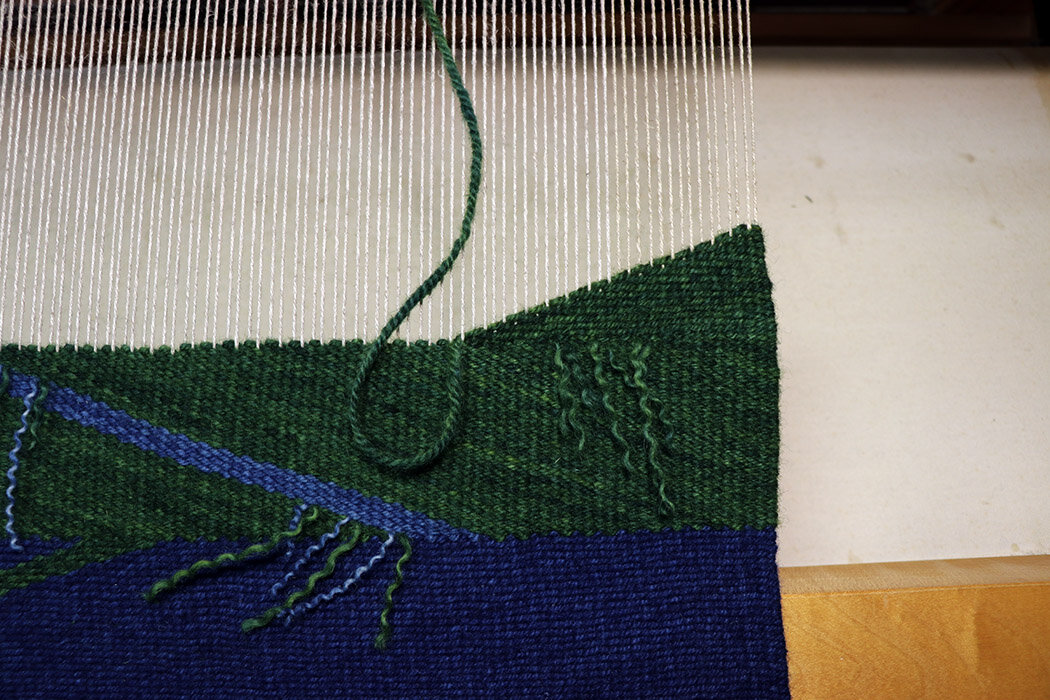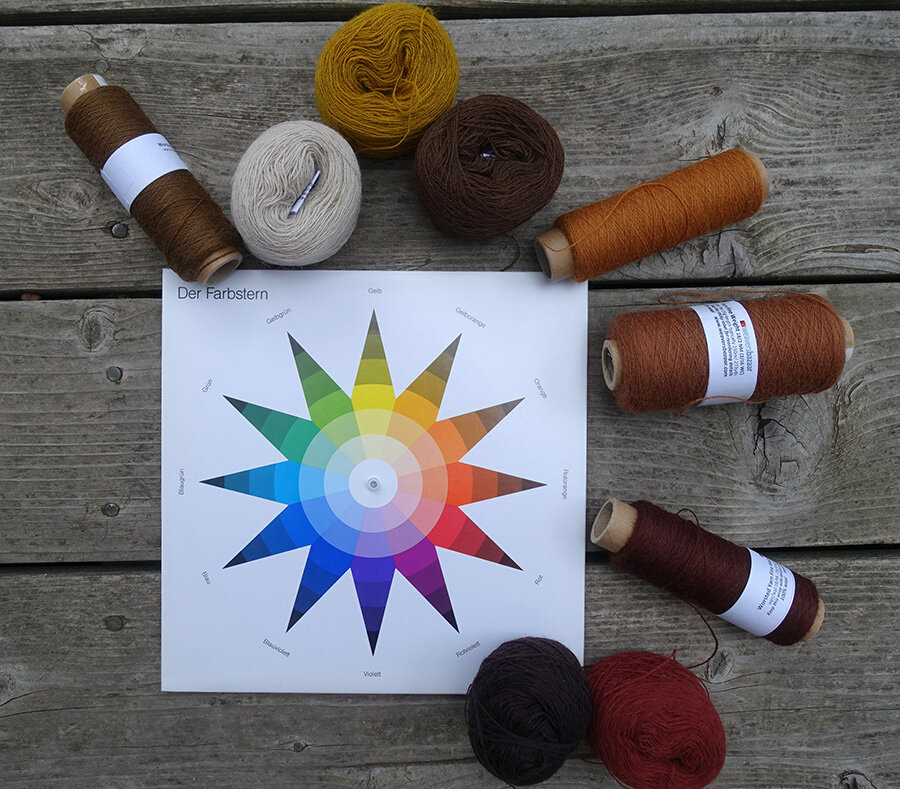Design Solutions for the Artist/Weaver
Once you have a grasp of the beginning techniques of tapestry weaving, the next challenge is to turn your expressive ideas into designs you can weave. It is time to grow your ideas and start realizing them in the images you create.
Creating a tapestry design that is successful relies on many underlying skills.
In this course, you will…
learn higher-level technical skills to increase weaving toolbox
delve into and discuss color theory
play with a variety of design techniques
explore the basic concepts of design
You’ll also hear from tapestry and fiber artists about their design practice and get their advice for working through design challenges.
All the materials are ready for you as soon as you sign up!
Rebecca periodically runs a live cohort of this course so students can benefit from learning together with real-time Q&A sessions.
You’ll also receive recordings to previous Q&A sessions. There are TONS of wonderful weaving questions from your fellow students and answers from Rebecca and others in the class.
If you’re interested in joining a live cohort, sign up for the newsletter here and keep an eye out for new class and cohort announcements.
Pricing
The course costs $294.
“So much to learn!!!
Everything I watch or read from the course so far links to more resources to watch and read, and act upon. It’s amazing and wonderful.”
What is the course like?
Each module contains information from most of these areas. Take a look at the course preview HERE to see the exact steps included in each module.
Artist interviews: This season we heard from Sarah Swett, Bhakti Ziek, Tommye Scanlin, Connie Lippert, Susan Martin Maffei, and Archie Brennan.
Behind the Scenes: Peeks into artist studios including mine and tips about aspects of the artist’s practice.
Maintaining Your Practice: Book recommendations and tips for ways to keep yourself motivated and moving forward including discussion of common artist blocks.
Nuts and Bolts: information about how equipment, materials, and techniques influence tapestry design.
Color and Design Principles: Discussion of foundational color and design principles and how they apply to tapestry weaving.
Recorded Question and Answer sessions: These were live from January to June of 2020 and now the recordings are available for you to watch – they are filled with weaving knowledge.
“I have really enjoyed the course. Surprisingly, for a course with focus on design, it has made me think more carefully about the technical aspects of tapestry weaving, and made me realise that a good design can be wasted if it is not beautifully executed, and that using the right materials and equipment contributes to a successful tapestry. This important lesson will hopefully allow me to improve my techniques and produce more consistent results in my weaving. Thank you Rebecca for a wonderful course.”
What is included in the course?
My goal for you is to get solid information that you can utilize to design your own tapestries as well as tips and tricks to maintain your tapestry practice. This is a process. You learned tapestry techniques by practicing each of them until you understood how they work. The same thing is true for design (or any other new thing you’re learning). It will take practice to get better at these new skills, but this course will give you the support you need to commit to that work.
Who is this course for?
This course is for anyone who wants to improve their design skills in the field of tapestry weaving whether you’re fairly new to tapestry or you’re well along in your practice. There are endless ways of designing for tapestry and the important thing is to know what the options are and have some help finding the best way to express your ideas.
We’ll start the course with some core content where I present The Success Path. Our journey to being intuitive designers of tapestries is a continuum and I will present information in layers so that people along this continuum can all find useful information in any module’s content.
Tapestry weaving is not always woven by the person who made the design. This course is for people who want to make their own designs and weave them. We call these people artist/weavers.
Who is this course NOT for?
This course is not for people who are absolute beginners in the world of tapestry. You need to have a handle on the basic techniques and I recommend first taking Introduction to Tapestry here, or the first part of Warp and Weft or the Little Looms course.
It is also not for professional tapestry weavers. If you make a living in the field, sell your work, regularly win awards, or have solo shows, this course is not for you… though many of those people will be the voices we hear in the course!
What materials will I need for Design Design Solutions for the Artist/Weaver Season 1?
We will cover everything you need in the course, but here’s an overview:
First things first, I’m expecting you to have basic tapestry weaving tools that you like to use. To start with you’ll just need a tapestry loom (could be a small untensioned loom, something like a Mirrix, or a floor loom), some warp, and some yarn you like. As you start designing it is quite possible that you’ll have ideas for which you’ll want different yarns or tools, but you won’t know that until you get there.
Second, everyone will use a different set of materials for design. I teach exercises or that use materials you may or may not have at home. You do not need to purchase these things before the course starts unless you’re certain you’ll use them and you want to make sure you have them on hand.
Expand the boxes below for specifics:
-
• pencil and eraser
• drawing pens (a fine Sharpie is enough or you can get some black Pigma Micron pens)
• colored pencils (this can be as simple kid friendly color pencils, but if you want to invest in high quality colored pencils - a small to medium set of Prismacolors is nice)
• sketchbook
• tracing paper
• plain copy paper
• window for lightbox (if you have a real one, great!)
• blue tape, masking tape, rubber cement, clear tape, scissors for paper
• Color wheel.
• a camera or cell phone with black and white option (or free online software to convert from digital image)
• I will talk a bit about using computers for design. If you have an iPad or computer with a drawing program, that will come in handy. This particular video will not be helpful for people who don’t want to design on computers. But don’t buy any expensive equipment or programs until you see inside the course! Computer design may not be for you nor is it a required component of designing for tapestry.
• Color aid paper or paint chips
-
• Occasionally I mess with art journaling materials which can get pretty out of hand: acrylic paint, watercolors, brushes, paint trays, glues, various sorts of pens. The list could go on forever. I am unlikely to present a specific activity requiring these sorts of materials, but there may be activities you would want to extend to use with them.
Below is another trailer video with clips of some of the interviews.
FAQ
There are extensive “frequently asked questions” pages under “FAQ” in navigation on this website. If you don’t see your question answered here, please look at the other FAQ pages HERE. Note the menu to the left with choices to help you narrow your search.
What do you mean by “seasons”?
“Seasons” just means that I’ll be doing more than one course about design. This is the first one and the material in subsequent seasons will build on this material. Design Solutions, Season 2 opened in January of 2021 and is now available in its entirety.
Design is a huge subject and it takes time to absorb it. This format allows ongoing study at your own pace. I recommend taking each season as it is available, but there is no obligation to register for any other season. Like other classes, each season is sold separately.
Will this course cover basic tapestry techniques?
No. This course will contain information for a wide range of abilities, but if you’re brand new to tapestry weaving, I recommend concurrently registering for a beginning tapestry techniques course like THIS one.
When can I register?
Registration is open! You can register at any point and take as long as you need to work through the material. You can return to the course material at any point in the future for review.
Will there be “real-time” requirements for this course?
Like all my courses, you can access the material on your own time. There are no set times you have to be present online.
Are there subtitles in the videos?
All of the Design Solutions seasons have full subtitles and transcripts for all videos. These are available for people who are hard of hearing but also so that you can search the transcripts for information in your PDF reader and find information quickly. They can also be helpful if you didn’t understand something someone said.
Image gallery
Below are images of some of the things coming in the course. Click to enlarge, hover for captions.
“I have really enjoyed the course. It has helped me consider what I am weaving and why - helped me to understand what images are meaningful to me. The interviews with the various tapestry artists was important in that process.
It has also helped me to understand that I need to think about how to make images weaveable and think in those terms when I am working out my designs.”




















